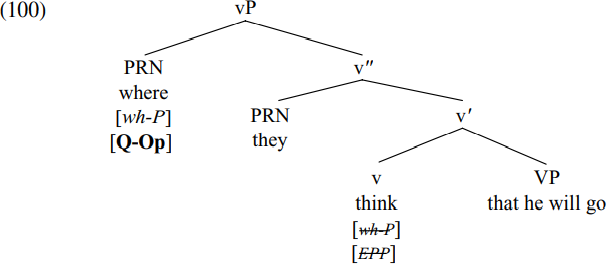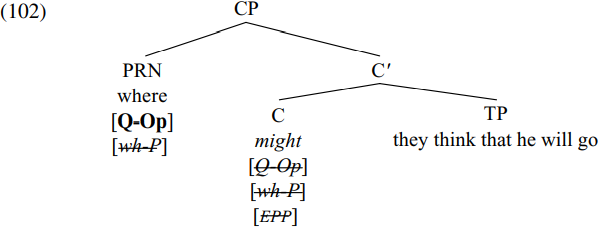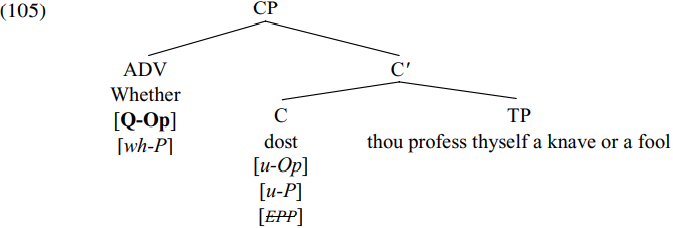


 Grammar
Grammar
 Tenses
Tenses
 Present
Present
 Past
Past
 Future
Future
 Parts Of Speech
Parts Of Speech
 Nouns
Nouns
 Verbs
Verbs
 Adverbs
Adverbs
 Adjectives
Adjectives
 Pronouns
Pronouns
 Pre Position
Pre Position
 Preposition by function
Preposition by function 
 Preposition by construction
Preposition by construction
 Conjunctions
Conjunctions
 Interjections
Interjections
 Grammar Rules
Grammar Rules
 Linguistics
Linguistics
 Semantics
Semantics
 Pragmatics
Pragmatics
 Reading Comprehension
Reading Comprehension|
Read More
Date: 2023-06-16
Date: 3-2-2022
Date: 2023-11-21
|
We have made a number of informal assumptions about how A-bar movement operations like wh-movement work without looking at the precise mechanism which drives this movement. Chomsky (1998) suggests that we should expect A-bar movement to operate in a fashion parallel to A-movement. More specifically, he draws the following parallel:
Take wh-movement. This would be point-by-point analogous to A-movement if the wh-phrase has an uninterpretable feature [wh-] and an interpretable feature [Q], which matches the uninterpretable probe Q of a complementizer in the final stage. (Chomsky 1988, p. 44)
In footnote 92, he makes the following additional observation (where TDEF denotes a defective T of the kind found in bare infinitival complements of raising and passive predicates):
To complete the analogy, C (and v with its  -set deleted) may have a non-specific P-feature analogous to [person] for TDEF, perhaps contingent on the assignment of an [EPP] feature to a phase.
-set deleted) may have a non-specific P-feature analogous to [person] for TDEF, perhaps contingent on the assignment of an [EPP] feature to a phase.
Let’s try and tease out what this means for wh-movement.
To make our discussion more concrete, consider the derivation of a sentence such as:

Assume that the derivation proceeds as discussed in relation to (13) Where is it thought that he will go? until we reach the stage of derivation when the complementizer that merges with its CP complement to form that he will go where (whose structure is shown in (15) above). Let’s suppose that a wh-word contains an interpretable operator feature marking whether it is a question operator, a relative operator, or an exclamative operator, so that interrogative wh-words have the interpretable feature [Q-Op] ‘question operator’. Let’s further suppose (again following Chomsky) that wh-words also have an uninterpretable wh-feature which makes them active: since this is a P-feature (i.e. a peripheral feature associated with movement to the periphery of a phase) in Chomsky’s terms, let’s denote the relevant feature as [wh-P]. In addition, we can take the complementizer that in (97) to have an [EPP] feature and contingent on this (to use Chomsky’s phrase) a ‘non-specific P-feature’. Let’s take the relevant P-feature to be an uninterpretable.
P-feature, and let’s assume that Chomsky’s remark that it is ‘non-specific’ means that it enters the derivation unvalued – i.e. it enters the derivation as an uninterpretable and unvalued peripheral feature [u-P]. Finally, let’s assume that the complementizer that (by virtue of being the head of a declarative clause) does not carry a Q-feature (i.e. does not carry a feature indicating that the clause is a question). Given these assumptions, at the point where the complementizer that is merged with its TP complement, we will have the structure shown in skeletal form below (where only features of immediate concern to us are shown):

Recall that we noted (in relation to our discussion of T-agreement and nominative case-marking) that when a probe P which is an A-head (like T) locates a matching goal G, uninterpretable (person/number/case) features on one can only be deleted by the other if the deleter is complete (i.e. if it carries a complete set of person/number  -features). Let’s therefore assume that in much the same way, when a probe P is an A-bar head which locates a matching goal G, the one can only delete any uninterpretable A-bar features carried by the other if the deleter is complete (i.e. if it carries both a P-feature/peripheral feature and an O-feature/operator feature). Given this assumption, the derivation will proceed as follows. The uninterpretable [u-P] feature of that in (98) makes it an active A-bar probe which searches for a goal that can value its unvalued [u-P] feature, and locates where: accordingly, where values the [u-P] feature of that as [wh-P] – or, in simpler terms, wh-agreement takes place between that and where. Since where is complete (by virtue of having both a P-feature and an O-feature), it can also delete the uninterpretable [wh-P] feature of that. Conversely, however, that cannot delete the uninterpretable wh-feature on where because that is not complete (since it has a P-feature but no O-feature). The [EPP] feature of that is deleted by moving where to spec-CP, so that at the end of the relevant phase we have the overt structure shown in skeletal form below (as throughout, the term overt structure being used informally to indicate that, in order to reduce visual clutter, we have not shown constituents which have a null spellout – e.g. traces):
-features). Let’s therefore assume that in much the same way, when a probe P is an A-bar head which locates a matching goal G, the one can only delete any uninterpretable A-bar features carried by the other if the deleter is complete (i.e. if it carries both a P-feature/peripheral feature and an O-feature/operator feature). Given this assumption, the derivation will proceed as follows. The uninterpretable [u-P] feature of that in (98) makes it an active A-bar probe which searches for a goal that can value its unvalued [u-P] feature, and locates where: accordingly, where values the [u-P] feature of that as [wh-P] – or, in simpler terms, wh-agreement takes place between that and where. Since where is complete (by virtue of having both a P-feature and an O-feature), it can also delete the uninterpretable [wh-P] feature of that. Conversely, however, that cannot delete the uninterpretable wh-feature on where because that is not complete (since it has a P-feature but no O-feature). The [EPP] feature of that is deleted by moving where to spec-CP, so that at the end of the relevant phase we have the overt structure shown in skeletal form below (as throughout, the term overt structure being used informally to indicate that, in order to reduce visual clutter, we have not shown constituents which have a null spellout – e.g. traces):

The TP complement of that undergoes transfer at this point in accordance with (7i) above. Note that the wh-feature carried by where has not yet been deleted and so remains active.
Assume that the derivation proceeds until the vP phase containing the transitive light verb associated with think is formed. Suppose that the transitive light verb also has an [EPP] feature and an unvalued, uninterpretable P-feature, but that the light verb has no O-feature (since only the head C of an interrogative clause has an operator feature). Much the same will happen on the vP cycle as happened on the CP cycle: that is, the unvalued [u-P] feature of the light verb will be valued as [wh-P] by wh-agreement with where, and thereafter deleted by complete where. The [EPP] feature of the light verb will trigger movement of where to a second specifier position above the external argument specifier they, so that at the end of the vP phase, we have the overt structure shown in (100) below:

Once again, note that the wh-feature of where has not yet been deleted and so remains active. In accordance with (7i), the VP that he will go will undergo transfer at this point (since a transitive vP is a phase, so that its complement undergoes transfer at the end of the vP cycle).
The vP in (100) is then merged with [T might] and the subject they raises to spec-TP, deriving the TP they might where think that he will go. The resulting TP is subsequently merged with a null affixal complementizer ø+ which has not only an uninterpretable [EPP] feature and an uninterpretable [u-P] feature, but also (because the clause which it heads is interrogative) an uninterpretable unvalued operator feature [u-Op]. Merger of the null complementizer with its TP complement derives the structure shown below (in which traces have been omitted to simplify exposition):

C is an active probe by virtue of its uninterpretable (and unvalued) peripheral and operator features, and locates where (which is active by virtue of its uninterpretable wh-feature) as a matching active goal. Where values the unvalued peripheral and operator features of C as [wh-P] and [Q-Op] respectively, and simultaneously deletes them (because where is complete by virtue of having both a P-feature and an O-feature). Since C is also complete, C can delete the wh-P feature of where (making it ineligible to serve as a goal for any other probe). The [EPP] feature of C is deleted by moving where into spec-CP. Since the null complementizer ø carries an affixal tense feature (not shown above), it triggers raising of the auxiliary might from T to C, so deriving the overt structure shown in highly simplified form in (102) below:

In the semantic component, a CP containing an interrogative operator in spec-CP will be interpreted as interrogative, and so (102) will receive an interpretation which can be loosely paraphrased as ‘What is the place such that they might think that he will go there?’, with where interpreted as an operator which binds a theta-marked trace in VP-complement position (the trace not being shown in (102) above).
There are two particular features of the analysis outlined here which merit further comment. One is that the analysis assumes that a wh-expression will remain an active goal until it encounters a C with an operator feature: only at that point will the wh-feature on the wh-expression be inactivated, making it ineligible to serve as a goal for another probe – hence making it ineligible to undergo further movement. We can illustrate this in terms of the following contrast:

In (103), both the main clause and the bracketed complement clause are interrogative in nature and hence contain a C with (initially unvalued) O- and P-features. Accordingly, movement of where to become the specifier of the bracketed complement clause in (103a) will result in the wh-feature of where being inactivated by the null C heading the bracketed complement clause, since the complement clause C is complete by virtue of carrying O- and P-features. Hence, once where moves to the italicized spec-CP position within the bracketed clause in (103a) its [wh-P] feature is deleted, making it inactive and hence unable to subsequently move into the bold-printed spec-CP position in the main clause in (103b).
The second feature of the analysis to note is that Chomsky’s assumption that an interrogative C contains an uninterpretable operator feature has important implications for the syntax of yes–no questions. What this in effect means (if yes–no questions contain the same kind of C constituent as wh-questions) is that yes–no questions must contain a null question operator in spec-CP. One reason for this is that the semantic component needs some means of identifying the relevant sentence as a question, and since Chomsky’s Q-feature on C is an uninterpretable feature, it clearly cannot be this feature which identifies the structure as a yes–no question since the relevant feature will be deleted in the course of the derivation and thereby become invisible to the semantic component. A second reason is that (by hypothesis) C in questions contains unvalued and uninterpretable O- and P-features, and these need to be valued and deleted by an appropriate constituent. Let’s therefore suppose that yes–no questions contain a null wh-operator – an invisible counterpart of the wh-adverb whether which could be used to introduce main-clause yes–no questions in Early Modern English sentences such as:

Let’s further suppose that in sentences like (104), whether is directly merged in spec-CP, and contains an uninterpretable [wh-P] P-feature and an interpretable [Q-Op] O-feature, and that the head C of CP contains unvalued and uninterpretable O- and P-features. This being so, the CP in (104) will have the structure (105) below at the point when whether is merged in spec-CP (assuming that merger of whether in spec-TP deletes the uninterpretable [EPP] feature of C):

The operator whether (which is active by virtue of its uninterpretable wh-feature) serves as a probe which can value and (by virtue of being complete – i.e. having both an O-feature and a P-feature) delete the two unvalued and uninterpretable O- and P-features of C. Conversely, C (being complete) can delete the wh-feature of whether. Hence, agreement in O- and P-features between whether and C will result in the following structure at the end of the relevant phase:

As desired, the only undeleted P-feature which survives at the end of the CP phase is the interpretable operator feature of whether. It may be that whether gets interpreted as a yes–no question operator because (unlike other wh-operators) it does not bind a trace (i.e. variable) – or its yes–no question interpretation may simply be part of the meaning of whether. We can suppose that yes–no questions in present-day English have a similar derivation, save that whether receives a null spellout in main clauses, in keeping with Rizzi’s (2000) hypothesis that root specifiers in certain types of structure have a null spellout under appropriate conditions. (Note that the analysis of yes–no questions outlined above assumes that C in yes–no questions has the same feature composition as in wh-questions and hence has uninterpretable [Q-Op] and [wh-P] features. However, an alternative possibility is that C in yes–no questions may contain an interpretable operator feature, but no [wh-P] feature: such an analysis would obviate the need for positing a null variant of whether in spec-CP in main-clause yes–no questions in English.)
I have developed an analysis of wh-movement which attempts to implement the suggestion made by Chomsky about possible parallels between A-movement and A-bar movement. The parallels should be obvious: for example, just as a (complete) T probe carries unvalued person/number features and an [EPP] feature which triggers movement of a goal to spec-TP, so too a (complete) C probe carries unvalued peripheral/operator features and an [EPP] feature which triggers movement of a goal to spec-CP; and just as intermediate T constituents (like raising to) are incomplete, so too intermediate C constituents are incomplete. Likewise, just as the goal in A-movement carries interpretable person/number features and an uninterpretable case feature which makes it active, so too the goal in A-bar movement carries an interpretable operator feature and an uninterpretable peripheral feature [wh-P] which makes it active. The parallels are not exact, however: for example, one difference is that (under the analysis presented here) the uninterpretable [wh-P] feature carried by the moved wh-expression enters the derivation already valued (so that it can wh-mark an intermediate complementizer), whereas the uninterpretable case feature carried by a nominal enters the derivation unvalued.
There are also empirical problems posed by our attempt to implement Chomsky’s analysis. To see why, let’s return to consider the structure of Belfast English questions like (38) above, repeated as (107) below:

Under the analysis of wh-movement sketched, the intermediate C in the bracketed complement clause will enter the derivation carrying an unvalued P-feature [u-P] which will be assigned the value [wh-P] via agreement with the wh-pronoun what. This predicts that the head C of the complement clause CP will be wh-marked in precisely the same way as it would be if the wh-pronoun were relative or exclamative. But in fact that head C of the bracketed complement clause CP seems to be marked as specifically interrogative in (107), and for this reason requires auxiliary inversion – unlike what happens in a relative clause structure like:

where the italicized C constituent heading the bracketed complement clause can be spelled out as that but not as an inverted auxiliary like did. This suggests that the italicized intermediate C is marked as interrogative in a structure like (107), and as relative in a structure like (108). What this might suggest is that C must carry a clause-type feature of some kind, valued as relative if the clause contains a relative pronoun, and interrogative if it contains an interrogative pronoun. If what marks a pronoun as interrogative or relative is an interrogative operator feature [Q-Op] or a relative operator feature [R-Op], then it would seem as if intermediate C constituents do indeed carry an unvalued operator feature [u-Op] which is valued as relative/interrogative via agreement with the wh-pronoun. If this is so, then the topmost C constituent in a wh-structure must carry some additional feature which makes it complete – perhaps a focus/topic feature (bearing in mind that it is sometimes claimed that interrogative pronouns behave like focused constituents, and relative pronouns behave like topics), or alternatively a scope feature. Details need to be worked out, but I will not attempt to do this here.
Clearly, this and other alternative analyses of A-bar movement operations need to be evaluated in future research – and obvious questions posed by multiple wh-questions answered (one such question being how we ensure that only the ‘highest’ wh-expression in a multiple wh-question in English carries whatever feature makes such expressions active for wh-movement, and how the wh-expressions which remain in situ can be bound by C (as Pesetsky 1987 argues they must be) if C contains no interpretable interrogative feature. The Minimalist Program is precisely that – a programme to guide research: consequently, in relation to many (indeed, most) aspects of syntax we have more questions than answers at present.
|
|
|
|
التوتر والسرطان.. علماء يحذرون من "صلة خطيرة"
|
|
|
|
|
|
|
مرآة السيارة: مدى دقة عكسها للصورة الصحيحة
|
|
|
|
|
|
|
نحو شراكة وطنية متكاملة.. الأمين العام للعتبة الحسينية يبحث مع وكيل وزارة الخارجية آفاق التعاون المؤسسي
|
|
|